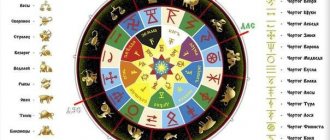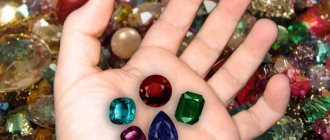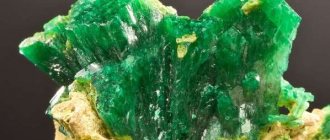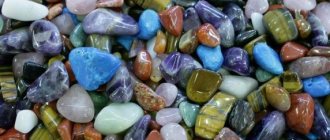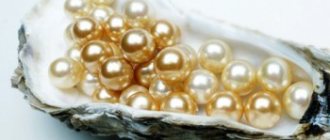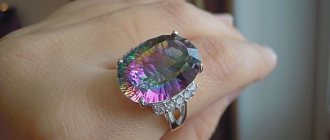Legends and stories about the power of crystals and stones.
For many centuries, legends and traditions of various civilizations about the power of crystals and stones have been preserved and passed on. The legends are varied and beautiful, like the facets of precious stones.
There is a beautiful Persian legend about precious stones, which says: “At the beginning of creation, God, the Creator of all things, created a beautiful, pure, harmonious world for the first people. To preserve it, he placed divine protection - the Firmament of Heaven. But the insidious Spirit of destruction and deception penetrated this perfect world, desecrated it and destroyed the Firmament of Heaven. Its fragments fell to the ground, turning into precious stones, but did not lose their inherent divine energy of protection and help. And since then they have served as a reminder of the perfect world and a guide to it. Each crystal represents a specific system of protection and expansion of consciousness. By concentrating great divine energy, he is able to help a person achieve perfection through purification.”
THE LEGEND OF DIAMOND AND GOLD.
The word "diamond" comes from the Greek word "adamas", which means "insurmountable", "invincible". The Arabs have a legend. In those distant, distant times, when the Blue Nile was so wide that even crocodiles could not swim across it, Gold and Diamond argued which of them was the most noble, the most powerful on Earth. - I! - said Gold. “I am cast on the crowns of sultans, shahs and kings, queens wear hammered gold wrists on their sleek hands, gold rings adorn their thin fingers, like lotus stamens. Because of me, so much blood has been shed on Earth that it could fill all the wells of the world and Lake Chad. You, Diamond, are just an insignificant appendage to my golden glory. “You’re mistaken, Gold,” objected Almaz, “bloody wars were also fought because of me, I also decorate the thrones, scepters and rings of pharaohs, rajas and shahins.” “Well, if so, then let’s ask the Sun which of us is more powerful and valuable,” suggested Gold, and they turned their question to the eternal luminary.
“I can’t hear you,” answered the Sun. “Come closer and tell me what you are arguing about on your faded star.” Then Gold and Diamond walked along the Milky Way and approached the Sun. But then the Gold turned red, turned pale and, melting, rained golden rain on the Earth. And the Diamond returned as sparkling and hard as it was before. Since then, Gold has never argued with Diamond again, once and for all losing the palm to him.
DIAMONDS AND EAGLES.
Diamond is the most popular gemstone. Biruni wrote down the following legend: diamond seekers covered a nest with an eagle chick with glass, and the eagle, noticing it and not being able to penetrate the nest, flies away, brings a diamond and throws it on the glass to break it. When there were a lot of diamonds, the seekers appropriated them and removed the glass so that the eagle would think that he had managed to break the glass. After some time, the searchers again covered the nest with glass, and the eagle again began to carry diamonds. Perhaps that is why among the names of the “king of stones” there is one more - “Eagle Stone”. This legend echoes the tale of the voyage of Sinbad the Sailor, which describes an ingenious method of mining diamonds. In one distant country, the bottom of the gorge is completely strewn with diamonds, but access there is blocked by hordes of poisonous snakes. To extract the precious stones, people threw pieces of meat from the surrounding mountains into the gorges. The eagles carried them with the diamonds stuck to their nests, and clever stone seekers took the diamonds from there.
GREEN DIAMOND.
There are many legends about colored diamonds that have survived to this day. The green diamond, as legend has it, first appeared in France in the town of Chartres. Here in the Carthusian monastery, in competition with the Italian monks who had been producing the famous Benedictine liqueur since time immemorial, the French holy brethren brewed Chartreuse liqueur. The taster at the monastery was an old rogue nicknamed Curious - Culotte. On this monk's finger was a simple silver ring with a small white diamond. Tasting the sweet emerald-green chartreuse every day, Curieuse-Culotte, in order not to get drunk to the point of green vestments and to remain among the tasters as long as possible, began to try the green drink made by the monks not with a thimble, as before, but to drip chartreuse onto his diamond and lick the sweet liquid from it . And yet, by the end of the day, Curiosity-Culotte was so drunk that two burly monks took him by the arms and dragged him into his cell. Noticing this. The abbot of the monastery, Abbot Durel, replaced the drunkard taster with a young monk. Waking up the next morning, Curiosity - Culotte looked at his diamond and suddenly saw that it was burning with a bright green fire. The monk tried to wash the stone with holy water, heated it over a lamp, but nothing helped. The diamond, as the legend says, remained green forever.
AMBER TEARS.
Almost all legends about amber are somehow connected with tears. Probably, the drop-shaped shape of some pieces of amber and its transparent color reminded people of them. In ancient, ancient times, at the bottom of the Baltic Sea, in a beautiful palace, lived a sea goddess, whose name was Jurate. And on the seashore there lived and fished a young and handsome guy named Kastistis. He sang funny songs and caught fish with nets, raising mud from the bottom and scaring Jurate’s favorite fish. The goddess sent mermaids to him, who conveyed her command to the fisherman not to throw his nets into the sea. But Kastistis did not listen to the mermaids and continued to do his job. Jurate became angry and surfaced to look at the one who dared to disobey her order. Seeing Castistis and hearing his voice, the goddess fell madly in love with the young fisherman. She took her chosen one to the bottom of the sea, to her magnificent palace, and made her her lover. And at that time the most lord of the gods was the formidable Perkunas. He learned that the goddess allowed herself to fall in love with a mere mortal, and he became terribly angry. He killed Kastistis with a strike of his lightning, destroyed Jurate's palace, and chained her to the bottom of the sea with a golden chain. Year after year goes by, and the goddess, entangled in a chain, cannot free herself. And she cries inconsolably over the dead Kostistis, and the sea takes away her tears and throws them ashore in the form of cooled golden drops - pieces of amber...
STONE OF THE AMAZONS.
Green-white, green, bluish-green stone, often of heterogeneous color due to pyrite inclusions of white and yellowish albite. The assertion that amazonite is named after its location in the sediments of the Amazon River has no basis. Amazonite products have already been found in ancient Egyptian burials. Before the discovery of the Amazon River, humanity still had more than one thousand years to live. In fact, the stone is named after the Amazons. The name “Amazon” itself means “Breastless”.
Traditions say that some Scythian women rubbed one breast with green stone powder, which retarded its growth. Is this where the legends about one-breasted women come from? Amazonite jewelry is found during excavations of Scythian burial mounds. By the way, the legends about one-breasted Amazons could well have a real basis. Indeed, according to modern medical data, amazonite powder is a way to inhibit cell growth. The soldiers who participated in the battles with the Amazons said that these women are fierce and bloodthirsty, and it is impossible to put them to flight, and you can defeat them only by killing them to the last. The Greeks, led by Hercules himself, who went to the land of the Amazons to get the belt of the Amazonian queen Hippolyta, could be convinced that they were excellent with weapons. Many Greek heroes died at the hands of the Amazons then. They paid dearly for the belt of the war god Ares, who gave it to the queen of the Amazons. Ancient Greek myths claim that Hippolyta's belt was made of green stones. Perhaps it was the Amazonites...
THE LEGEND OF AMETHYST.
The God of Wine, surrounded by beautiful Bacchantes, was magnificent. In the beauty of his features and the tenderness of the skin of his face, devoid of vegetation, Bacchus did not differ from his girlfriends. Clothing and behavior also could not serve as a distinction. All this often made the great goddess Hera, the wife of the supreme god Zeus, indignant. Yes, Dionysus, aka Bacchus, is gentle, kind and cheerful. But he can be formidable, becoming unpredictable in his actions caused by excessive consumption of wine. Once, under the influence of wine fumes, enraged, he ordered the lions to tear into pieces the people they met. It so happened that at this time a beautiful nymph named Amethyst went out for a walk. The enraged lion rushed towards her, but his claws encountered a hard stone and slid along the polished smooth body of the petrified maiden. It turns out that Amethyst turned to the Olympian gods with a request for salvation, and they turned her into a transparent white stone. Waking up in the morning, rubbing his head, freed from alcohol, Bacchus could not remember what he had done the previous evening. He went to meet Selenus, his teacher and feasting friend, and saw on the way a statue of a beauty, transparent as glass. Then he remembered... Grieving over what he had done, he approached the stone maiden, trying with his breath to bring her back to life. It didn't help. Then he began to water the statue with life-giving streams of wine. It was not possible to revive the nymph Amethyst. But the beauty’s body, under the influence of wine, acquired a pinkish-violet color and, in the light of the sun, sparkled with sparks of a living and at the same time stony life, unknown to the god of wine.
AGATE.
Agate is a multi-layered variety of chalcedony, painted with multi-colored patterns and landscapes. The name of an agate is given depending on the pattern, and there are many such names: moss agate, patterned, landscape, cloud, landscape, etc. Most often, the pattern of agate resembles an eye. According to one of the ancient legends, evil came to earth. The forests were burning, everything that could burn was burning. All living things hid underground. There was no force that could fight the black sorcerer - the personification of evil. And the gods sent a white eagle to earth. The battle was terrible, the skies turned the color of blood, the water in the lakes boiled. The black sorcerer has disappeared. But the white eagle itself received many wounds in the battle, life left it, and it fell to the ground and became a stone. And his eye, having turned into agate, continues to look at people, separating good deeds from evil. Agate is also called the “Eye of the Creator.”
BRAHMA SAPPHIRES. In time immemorial, when the world was young and fresh, the gods ruled it undividedly, feasting in their transcendental heavenly palaces on Mount Kailash when free from the burdens of power. For people, there was no hotter dream than to go to heaven, to see with their own eyes the golden palaces strewn with unprecedented gems, where eternal spring reigns and death recedes forever. One of the people once prayed to the supreme god Brahma: they say, he wants nothing more than to see the seventh heaven, the highest of all - and I must add that according to Hindu tradition, there were... seven heavens. Brahma took pity on the unfortunate man, but still acted in his own way: he did not invite the arrogant mortal to the abode of the gods, but took a cup with the drink of immortality - amrita - that the gods drink at feasts, and sprinkled it all over the world. Falling down, the splashes turned into magnificent blue stones - sapphires, and quite by accident, most of the drops spilled over Ceylon, from where King Solomon himself brought precious blue gems to please his wife, the beautiful Sheba. But, of course, Brahma’s original goal was not to create jewelry for the wife of the great sage. The fact is that, looking into the shimmering depths of sapphires, people saw there a reflection of paradise, real nirvana - and the longing for the heavenly city no longer tormented them, because they had consolation. This is the essence of the stories about sapphires: along with greatness, this stone brings with it humility in the face of the inevitable and divine wisdom, and with it the hope that one day we will see our seventh heaven. EMERALD LEGEND. Emerald has always been recognized as one of the most powerful and mysterious talismans. It was very highly valued during antiquity. According to one of the legends that surrounded the name of the cruel Roman Emperor Nero, who burned most of Rome for personal reasons, he had a monocle carved from a single emerald. It was through this monocle that Nero looked at the fire and gladiator fights. There is another legend associated with the emerald. In the VI century. BC. The Samian ruler Polykratos decided to appease the gods with a generous sacrifice. He threw his favorite ring with a magnificent emerald into the sea. But the gods did not want to change their anger to mercy and did not accept his sacrifice - the very next day the ring was found in the stomach of a freshly caught fish. AQUAMARINE OF POSEIDON. During the times of Ancient Rome and Ancient Greece, it was considered a talisman of the ocean god Poseidon (Neptune). What to give to the beauty of the earth? Ten two most beautiful pearls? Or the stone that is with me, Which serves as a talisman of the sea? – Neptune sighed, looking at the wondrous stone. “Isn’t my stone too transparent?.. But, it seems, in a silver outfit, the earthly beauty will like it.” Giving his gift to the earthly girl, Neptune hoped that the stone would tie the beauty’s heart with love threads and make her love for him constant. Probably, the god of the seas was not mistaken in the action of his talisman. And now this stone is the guardian of love.
"Black Orlov"
“Black Orlov” is a black diamond weighing 67.5 carats, which has an interesting history.
It is also known as the "Eye of Brahma". According to a report in The Independent in the early 1800s, a monk removed a diamond from the eye of a statue of Brahma (the creator god in Hinduism) at a temple near Pondicherry.
The curse is said to have caused three diamond owners to commit suicide by jumping from great heights.
Zh.V. Pari, a diamond merchant, brought the Black Orlov to the United States. In 1932, he jumped from a building in New York after the diamond was sold. Fifteen years later, two Russian princesses, Nadya Vegin-Orlova and Leonilla Golitsyna-Baryatinskaya, also committed suicide.
To rid the stone of its curse, owner and gem dealer Charles F. Winson recut the black diamond.
"Black Orlov" is now set in a diamond brooch suspended from a necklace.
Wandering Pearl
Not all cursed jewelry is diamonds. Pearls are also not at all simple.
According to the website of pearl supplier Assael, the "Peregrina" pearl (literally "Wandering Pearl", or "Wanderer") was found off the coast of Panama in the mid-16th century.
Don Pedro de Temez, administrator of the colony in Panama, personally delivered the pearl to Spain and presented it to the future King Philip II, who in turn gave it to Queen Mary I of England.
The pear-shaped pearl, weighing 50.56 carats, appeared in a portrait of Queen Mary painted by Anthony More in 1554.
Queen Mary, a devout Catholic, burned hundreds of Protestants at the stake during her reign, earning her the nickname Bloody Mary. They say that Bloody Mary wore this pearl to all her executions.
It is believed that "Peregrina" destroyed the love of all the royals who wore it.
Queen Mary had a difficult relationship with her husband, King Philip II of Spain, who lived abroad for most of their marriage.
When she died during the influenza epidemic of 1558, Philip II wrote: "I feel sorry for her death." Soon after this, he proposed marriage to his half-sister Elizabeth, but she refused him.
Over the next centuries, this amazing pearl changed hands several times and was eventually sold at Sotheby's in London in 1969.
Actor Richard Burton paid $37,000 for Peregrina and gave it to his then-wife, actress and famous jewelry lover Elizabeth Taylor, for Valentine's Day. The jewelry house Cartier invited the star to attach a pearl to a necklace as a pendant.
Taylor was notorious for her numerous marriages: she had seven husbands throughout her life (she married Burton twice).
After her death in 2011, an anonymous buyer paid more than $11 million for Peregrina at Christie's sale of Taylor's jewelry.
Diamond "Kohinoor"
The history of the Kohinoor diamond began in India. It was originally part of a luxurious throne commissioned in 1628 by Mughal ruler Shah Jahan, according to the Smithsonian Institution.
It took seven years to create the ruler's throne. Covered in rubies, emeralds, diamonds and pearls, it cost four times more than the Taj Mahal to build. The Kohinoor diamond was set in the head of a peacock and adorned the top of the throne.
When the Persian ruler Nader Shah invaded Delhi in 1739, the Peacock Throne and the Kohinoor Diamond were stolen and taken to modern-day Afghanistan.
The stone changed hands several times and eventually found its way to England to become part of the royal crown. But throughout its journey, the diamond sowed misfortune.
In 1849, during a turbulent period in Indian history, a 10-year-old boy, Duleep Singh, laid claim to the Peacock throne and all its riches. But the British imprisoned the boy's mother, Rani Jindan, and a well-armed Sikh army recovered the diamond.
Former Indian Ambassador to the US Navtej Sarna spoke about the Kohinoor curse at an event held by the Asia Society in October last year.
According to Sarna, the diamond's journey from India to England was very difficult. There was an outbreak of cholera on the ship. Filled with sick passengers, the ship was denied entry into a nearby port and had to continue sailing through a severe storm.
Finally the diamond arrived in London, but the troubles did not end there.
Shortly afterwards, Queen Victoria was struck with an iron-headed cane by a strange man and suffered a black eye. Around the same time, its former prime minister, Robert Peel, died after falling from his horse and being crushed by it.
According to Sarna, the diamond was put on public display, but Prince Albert did not like its appearance. To make the stone more attractive, it was decided to re-cut it.
Today, according to the Gemological Institute of America, the Kohinoor Diamond is an oval-shaped diamond weighing 105.60 carats.
The last time this stone was seen in public was in 2002. It was placed on the coffin of Queen Mother Elizabeth.
